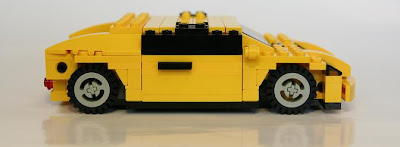
In the lead-up to the debut of the movie “Transformers,” there was already plenty of Transformers merchandise available. My son, who was 2 ½ years old at the time was instantly entranced. While my wife was strolling him through the bookstore he grabbed a Transformers calendar without her noticing. When she got to the register he then used his charms to convince her to buy it.
The Challenge
This got me to thinking. Wouldn’t it be fun to build my son a car out of Legos that could transform into a robot? After all, how hard could it be? I decided to give it a shot and I set myself the following design goals and constraints:
- Build a Lego model that has two forms: a sports car and a robot
- Folks looking at it agree that each form is clearly recognizable as that form
- On casual inspection, it doesn’t look like it transforms
- 100% Lego, no other parts, and no glue
- Easily held in one hand
- Strong (parts don’t fall off easily during use)
- Robot form can stand on its own
- The model can easily transform from one form to the other
- Model is completely connected and transformation does not require the addition or removal of any parts
- Fully articulated
As the project progressed, I wasn’t thinking of it as an exercise in iterative design or a formal project, it was always just something I did for fun in my spare time. I didn’t realize the link to iterative design until I started talking to people about the history of the project.
Transforming Requirements Into Working Software
When working with software, even if you have clear requirements that you have validated with users, it is not always clear how you will implement them. The search for a solution has two possible components: thinking about how to do something and implementing something. When thinking about how to do something, that’s really just fantasizing. Of course, it is fantasizing that is focused on producing something real, and it is more likely to produce something real than fantasizing about winning the lottery, but it is still fantasizing.
Requirements, analysis, specifications, and design are all examples of fantasizing. Yes, it is useful to do it, and you will often hit on solutions or eliminate problems much more quickly and much more economically than creating something real without giving it the same amount of thought, but fantasizing is only an approximation of reality, an interlocking web of educated guesses. Not until you actually attempt to create something real will you find out how all of the individual requirements interact and the real costs and difficulty involved. You don’t always find a clear match between requirements and implementation that is cost-effective to implement. In this case you have four paths forward: implement with the closest match and hope for the best, search for new possibilities, invent new possibilities, or shelve the project.
Transforming Lego Car, Iteration 1
The first attempt to build the transforming Lego car didn’t go very well. I was able to create a reasonable looking car which had lots of interior space for the mechanics needed to transform, but creating the sliding parts and the joints proved to be more difficult than I had imagined. I had lots of different hinges, flat parts, special joints, and Technic parts, but all of the possibilities I came up with were either too big, too fragile, too loose, or didn’t support articulation well enough. I was stumped. After a quick trip to the nearby Lego store to see if there was something I had missed, I reluctantly decided to shelve the project.
From a requirements perspective, I had satisfied requirements 2-6, which is half of the requirements. Of course, it was easy to satisfy "doesn't look like it transforms" because it didn't transform at all. :-) From an Agile perspective, the car was fully functional as a car in its own right, and I had discovered lots of valuable information that would help with later iterations of the car.
Little did I know that a hidden bias had kept me from seeing what was right in front of me. It wasn't until a couple of months later that serendipity broke through that bias and brought together the necessary ingredients for the first transforming version of the car.
Next: Part II (of 2)

1 comment:
Web Design Poole :We are Top Web Design Company in Bournemouth. We offer Website Design in Poole, Bournemouth & Hampshire. Visit us for cheap website design services.
Post a Comment